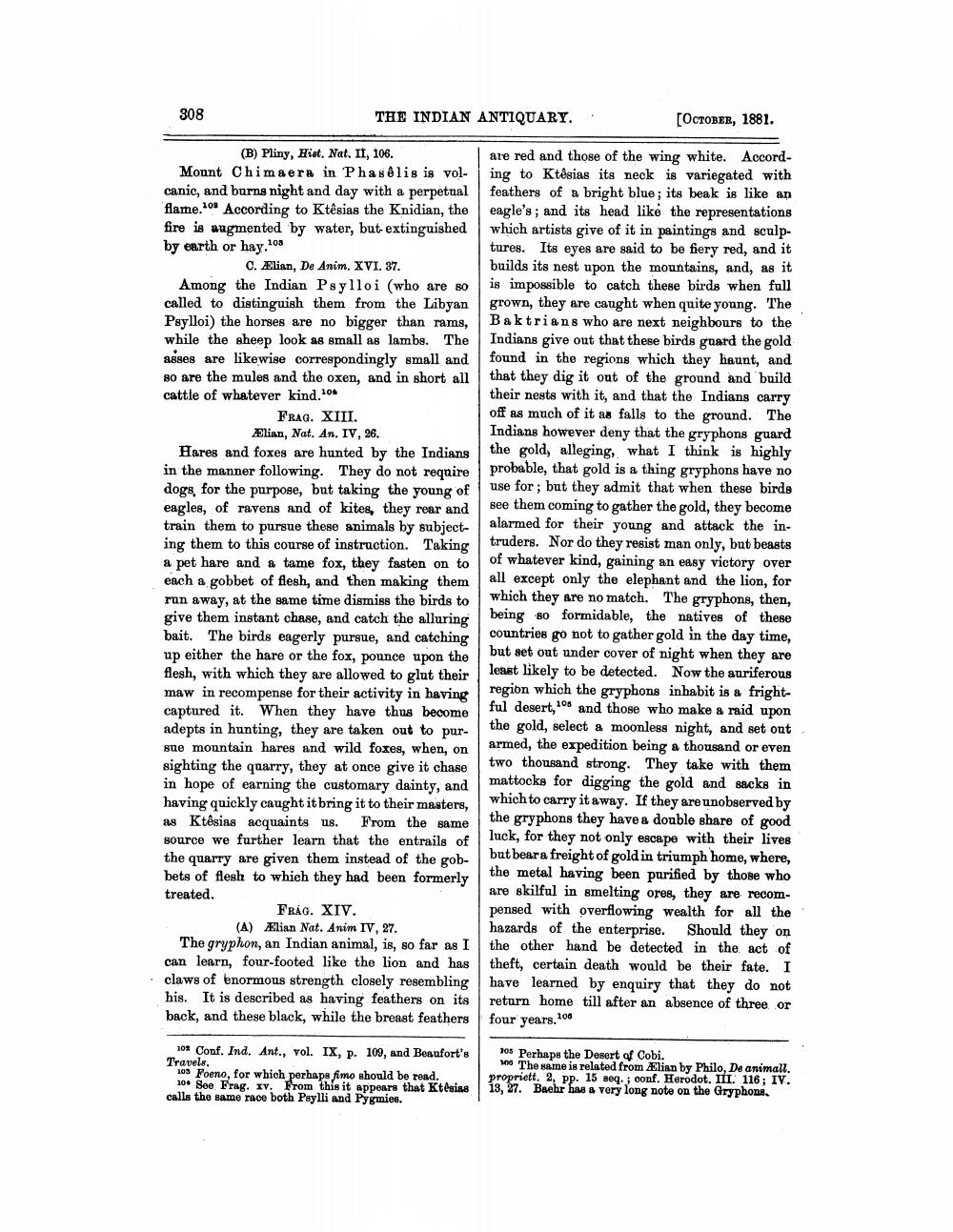________________
308
THE INDIAN ANTIQUARY..
[OCTOBER, 1881.
(B) Pliny, Hist. Nat. II, 106. Mount Chimaera in Phaselis is vol- canic, and burns night and day with a perpetual flame.10* According to Ktêsias the Knidian, the fire is augmented by water, but extinguished by earth or hay.108
C. Ælian, De Anim. XVI. 37. Among the Indian Psylloi (who are so called to distinguish them from the Libyan Psylloi) the horses are no bigger than rams, while the sheep look as small as lambs. The asses are likewise correspondingly small and 80 are the mules and the oxen, and in short all cattle of whatever kind.104
FRAG. XIII.
Alian, Nat. An. IV, 26. Hares and foxes are hunted by the Indians in the manner following. They do not require dogs for the purpose, but taking the young of eagles, of ravens and of kites, they rear and train them to pursue these animals by subjecting them to this course of instruction. Taking a pet hare and a tame fox, they fasten on to each a gobbet of flesh, and then making them run away, at the same time dismiss the birds to give them instant chase, and catch the alluring bait. The birds eagerly pursue, and catching up either the hare or the fox, pounce upon the flesh, with which they are allowed to glut their maw in recompense for their activity in having captured it. When they have thus become adepts in hunting, they are taken out to pursue mountain hares and wild foxes, when, on sighting the quarry, they at once give it chase in hope of earning the customary dainty, and having quickly caught it bring it to their masters, as Ktësias acquaints us. From the same source we further learn that the entrails of the quarry are given them instead of the gobbets of flesh to which they had been formerly treated.
FRAG. XIV.
(A) Ælian Nat. Anim IV, 27. The gryphon, an Indian animal, is, so far as I can learn, four-footed like the lion and has claws of bnormous strength closely resembling his. It is described as having feathers on its back, and these black, while the breast feathers
are red and those of the wing white. Accord ing to Ktësias its neck is variegated with feathers of a bright blue; its beak is like an eagle's; and its head like the representations which artists give of it in paintings and sculptures. Its eyes are said to be fiery red, and it builds its nest upon the mountains, and, as it is impossible to catch these birds when full grown, they are caught when quite young. The Baktrians who are next neighbours to the Indians give out that these birds guard the gold found in the regions which they haunt, and that they dig it out of the ground and build their nests with it, and that the Indians carry off as much of it as falls to the ground. The Indians however deny that the gryphons guard the gold, alleging,. what I think is highly probable, that gold is a thing gryphons have no use for; but they admit that when these birds see them coming to gather the gold, they become alarmed for their young and attack the intruders. Nor do they resist man only, but beasts of whatever kind, gaining an easy victory over all except only the elephant and the lion, for which they are no match. The gryphong, then, being 80 formidable, the natives of these countries go not to gather gold in the day time. but set out under cover of night when they are least likely to be detected. Now the auriferous region which the gryphons inhabit is a frightful desert, 20s and those who make a raid upon the gold, select a moonless night, and set ont armed, the expedition being a thousand or even two thousand strong. They take with them mattocks for digging the gold and sacks in which to carry it away. If they are unobserved by the gryphons they have a double share of good luck, for they not only escape with their lives but beara freight of gold in triumph home, where, the metal having been purified by those who are skilful in smelting ores, they are recompensed with overflowing wealth for all the hazards of the enterprise. Should they on the other hand be detected in the act of theft, certain death would be their fate. I have learned by enquiry that they do not return home till after an absence of three or four years.106
101 Conf. Ind. Ant., vol. IX, p. 109, and Beaufort's Travels.
103 Foeno, for which perhaps fimo should be read. 10. See Frag. IV. From this it appears that Ktégias calls the same race both Paylli and Pygmies.
105 Perhaps the Desert of Cobi.
10. The same is related from Ælian by Philo, De animall. propriett. 2, pp. 15 seq.; conf. Herodot. III. 116; IV. 13, 27. Baehr has a very long note on the Gryphons




